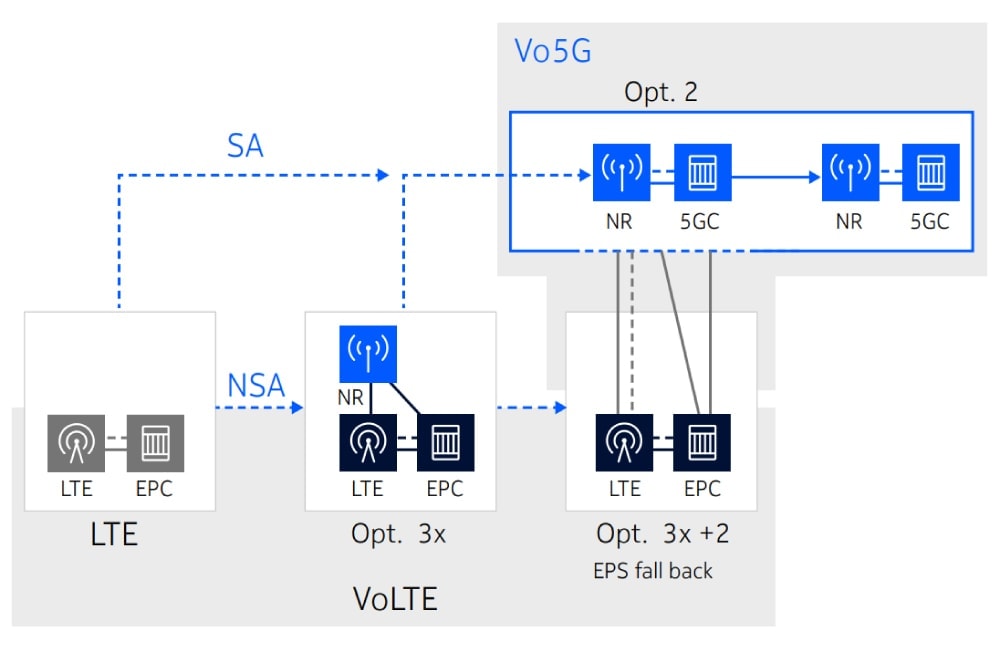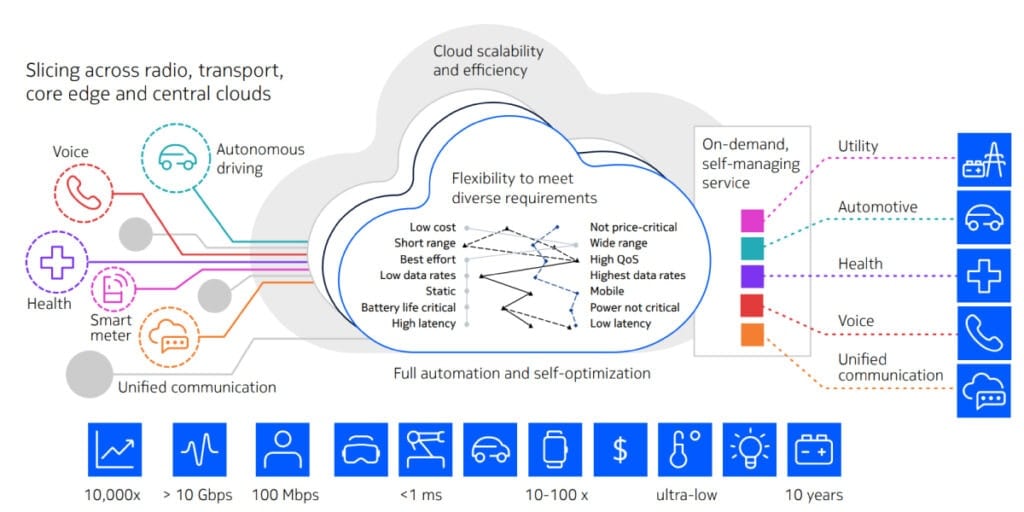The Future of Voice
Voice communication is often the cornerstone of bundled packages offered by communications service providers (CSPs). Mobile users have come to anticipate it as an integral part of their plans, and its significance extends to the various innovative data services made possible by 5G. However, the seamless integration of 5G with legacy technologies is imperative.
While 4G brought about crystal-clear calls through IP Multimedia Subsystem (IMS) voice, 5G represents the culmination of the voice core’s evolution towards IMS. This journey started with LTE in mobile networks, and its evolution paves the way for new, immersive voice and video experiences tailored to consumers and businesses.
How Vo5G Works
Vo5G mirrors the voice service structure in today’s 4G networks. In 4G LTE, voice calls are executed as end-to-end Voice over IP (VoIP) connections managed by an IMS core. Both voice and video communication services within these networks operate over the IP data connection.
When a call is made over LTE, it’s termed Voice over LTE (VoLTE), and when conducted over Wi-Fi, it’s dubbed Voice over Wi-Fi (VoWi-Fi).
IMS is made up of various network elements with standardized functions and interfaces regulated by bodies like the 3GPP (3rd Generation Partnership Project). While IMS can facilitate voice calling over any IP interface, the GSM Association defines “IMS profiles” to ensure carriers can construct interoperable networks. For instance, IMS VoLTE is delineated by GSMA IR.92.
Vo5G is typically implemented in one of two manners within a 5G network, depending on the chosen deployment approach by the Communication Service Provider (CSP).
Many CSPs initiate their 5G rollouts with 3GPP Option 3x. Under this model, the CSP possesses an existing 4G LTE network and introduces the 5G network alongside it. 5G NR (New Radio) is a secondary cell, while the core technology remains EPC (Evolved Packet Core). All RAN-core signaling is transmitted over the master cell, which is 4G. User Equipment (UE) registers to the IMS over EPS (Evolved Packet System). When a voice call is initiated or received on a 5G-enabled device, it follows typical VoLTE procedures over the EPS system.

Alternatively, a CSP may opt for 3GPP Option 2, deploying the 5G network as a standalone independent of any other network. In such instances, voice communications are facilitated by an IMS core, offering voice as a 5G application service. The IMS network in this scenario generally adheres to GSMA NG.114 as the IMS profile, sanctioned and issued by the GSMA. Voice services on this type of network are denoted as Voice over New Radio (VoNR).
During the early stages of 5G deployment, geographic coverage may be incomplete. To address this, an operator deploying 3GPP Option 2 may utilize “EPS fallback for IMS voice.” This procedure ensures that when a mobile device moves out of a 5G NR coverage area during a VoNR voice call, it seamlessly transitions to using the 4G network. This approach minimizes interruptions to the user’s in-call experience, as handovers occur at call setup rather than during an ongoing call, mitigating any potential disruptions caused by delays.
In the context of 5G, there are two primary methods for operators to integrate voice services:
VoLTE
In cases where a 5G Core is not yet deployed, voice services for 5G users are facilitated through the VoLTE network, which comprises LTE Radio, Evolved Packet Core (EPC), and IMS. Meanwhile, 5G enhanced Mobile Broadband (eMBB) services are delivered through the 5G Radio and the augmented LTE/EPC infrastructure.
Vo5G/VoNR
With the deployment of a 5G Core, voice services are integrated using the 5G Core and IMS functionalities, while 5G use cases are supported by New Radio (NR) technology and the 5G Core.
VoWiFi
Additionally, the access-agnostic 5G core supports Voice over Wi-Fi (VoWiFi), which facilitates fixed and wireless connectivity across various technologies, including licensed, unlicensed, 3GPP, and non-3GPP. This capability enables the seamless delivery of converged voice services.
The IMS network comprises distinct network elements such as the Session Border Controller (SBC), Call Session Control Function (CSCF), Telephony Application Server (TAS), and Media Resource Function (MRF), each of which plays a crucial role in enabling efficient voice communication within the network.
Irrespective of whether VoNR or EPS fallback is selected, standardized voice and video communication services necessitate an IMS core to deliver the service within a 5G network.
IMS treats voice services as “access agnostic,” meaning it can cater to voice services across various access types, including fixed, cable, 2G/3G, and any 5G deployment model. However, since 5G mandates the presence of an IMS network to handle voice services across all deployment types, the advent of 5G acts as a catalyst accelerating the modernization of voice cores to IMS from older technologies in CSP networks.
Due to the diverse service opportunities created by 5G, voice services require a commensurate level of flexibility. Open APIs are the linchpin for evolving voice services within the IMS ecosystem. These open APIs allow for customized call logic, expanded functionality, and the creation of new services across various domains, such as call direction, control, notification, user interaction, history, terminal status, and self-care.
This additional functionality can originate from the IMS vendor, CSP, ecosystem partners, or other service providers, fostering a dynamic environment where new services can emerge from anywhere within the global services ecosystem rather than being constrained by the resources of a select few providers.

Features and Benefits of Vo5G
As the communication landscape evolves, Vo5G is becoming an increasingly pivotal technology. It offers enhanced voice services and lays the groundwork for many innovative applications, underlining its significance in the 5G ecosystem. Its many features and benefits pave the way for the future of communication, particularly with the advent of Voice over New Radio (VoNR).
Here are some key features and benefits:
Critical Enabler for 5G Voice Services
VoLTE is a pivotal element in the transition of voice services from 3G and traditional Circuit Switched (CS) mobile networks to the advanced 4G LTE network, positioning it strategically in the evolution of telecommunications.
Flexible Deployment Options
Whether through the early deployments utilizing Non-standalone (NSA) Option 3x or the comprehensive Standalone (SA) Option 2, Voice over 5G Core offers flexible deployment strategies. Regardless of the chosen option, the 3GPP IP Multimedia Subsystem (IMS) remains the underlying technology foundation, ensuring seamless integration.
Highly Customized Virtual Networks
5G leverages a Service Based Architecture (SBA) coupled with cloud-native software, incorporating open interfaces and network slicing capabilities. These components converge to deliver unparalleled flexibility, granularity, and scalability, catering to the diverse needs of Communication Service Providers (CSPs) and ensuring optimized performance in varied scenarios.
Voice Over New Radio – The Next Generation
Next-generation voice services in 5G usher in a new era, with Voice over New Radio (VoNR) poised to redefine communication by harnessing high bandwidth and low latency capabilities, empowered by the 5G Stand-Alone Core and 5G Radio technologies.

The advent of VoNR unlocks untapped potential for CSPs and their business clientele, offering avenues to explore new revenue streams. By seamlessly integrating VoNR into advanced 5G services, CSPs can elevate user experiences and attract consumer and industrial attention.
Immersive Experiences
VoNR facilitates crystal-clear voice calls and immersive audiovisual encounters, enhancing the quality of communication to unprecedented levels. This enhancement opens avenues for interactive communication, enabling CSPs to offer specialized services like immersive multimedia conferencing, remote collaboration platforms, virtual assistants, and interactive entertainment, thereby expanding revenue horizons.
VoNR Programmability
Leveraging VoNR’s extensive programmability, CSPs can seamlessly integrate it with other innovative technologies, such as augmented reality, virtual reality, and IoT. This combination allows CSPs to create compelling service packages that resonate with consumers, offering unique value propositions and fostering customer engagement.
Industry-Specific Applications
VoNR paves the way for tailored solutions across various industries. From integrating 5G voice services into telemedicine for remote diagnostics to facilitating real-time language translation services, VoNR unlocks possibilities. Additionally, applications like live event broadcasting with immersive audio and interactive gaming experiences with integrated voice functionalities cater to specific industry needs, driving innovation across sectors.
Low Latency Characteristics
VoNR’s low latency ensures reliable and instantaneous voice communication, making it ideal for critical applications requiring real-time interactions. Industries such as public safety, healthcare, and industrial automation benefit significantly from this level of reliability, enhancing operational efficiency and safety measures.
About Infinity Technology Solutions
Infinity Technology Solutions specializes in broadband and critical communications infrastructure development. We help our channel partners create and deploy private wireless, microwave backhaul, IP/MPLS, and optical networking technologies.
For more information, give us a call or fill out the contact form below.